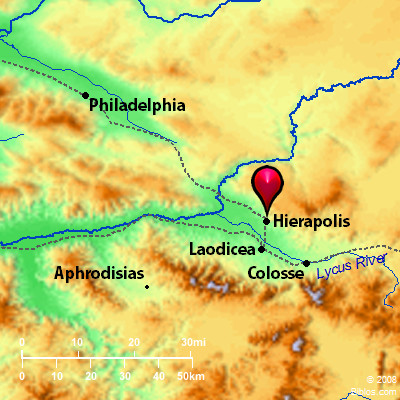Atlas  Hierapolis and surrounding area Maps Created using Biblemapper 3.0 Additional data from OpenBible.info Occurrences Colossians 4:13 For I testify about him, that he has great zeal for you, and for those in Laodicea, and for those in Hierapolis.Encyclopedia HIERAPOLIShe-er-ap'-o-lis (Hierapolis, "sacred city"): As the name implies, Hierapolis was a holy city. It was situated 6 miles from Laodicea and twice that distance from Colosse, on the road from Sardis to Apamea. Though its history is not well known, it seems to have been of Lydian origin, and once bore the name of Kydrara. The Phrygian god Sabazios was worshipped there under the name Echidma, and represented by the symbol of the serpent. Other local deities were Leto and her son Lairbenos. Though called the holy city, Hierapolis was peculiarly regarded as the stronghold of Satan, for there was a Plutonium, or a hole reaching far down into the earth, from which there issued a vapor, even poisoning the birds flying above. It is supposed that upon a stool, deep in the Plutonium, a priest or priestess sat, and, when under the influence of the vapor, uttered prophecies valuable to those who sought them. Though a stronghold of Satan, Hierapolis early became a Christian city, for, according to Colossians 4:13, the only place where it is mentioned in the New Testament, a church was founded there through the influence of Paul while he was at Ephesus. Tradition claims that Philip was the first evangelist to preach there, and it also claims that he and his two unmarried daughters were buried there; a third who was married, was buried at Ephesus. Several of the early Christians suffered martyrdom at Hierapolis, yet Christianity flourished, other churches were built, and during the 4th century the Christians filled the Plutonium with stones, thus giving evidence that the paganism had been entirely supplanted by the church. During the Roman period, Justinian made the city a metropolis, and it continued to exist into the Middle Ages. In the year 1190 Frederick Barbarossa fought with the Byzantines there. HIERAP'OLIS, a city of Phrygia, stood on a high bluff, with a high mountain behind it. It is about 90 ms. e. of Ephesus,'having the Mediterranean equidistant on the w. and on the s. and 560 ms. n.n.w. of Jerusalem. It has extensive ruins and many hot springs which deposit lime and give it a white appearance and hence its name the Cotton Castle, or in the Turkish Pambouk Kalessi. Its name in Scripture is only in Col. 4:13. Strong's Greek G2404: HierapolisHierapolis, a city in Asia |



